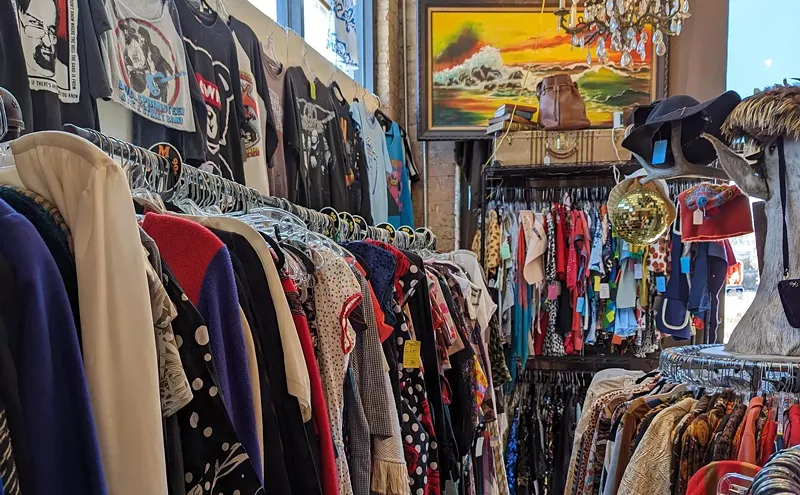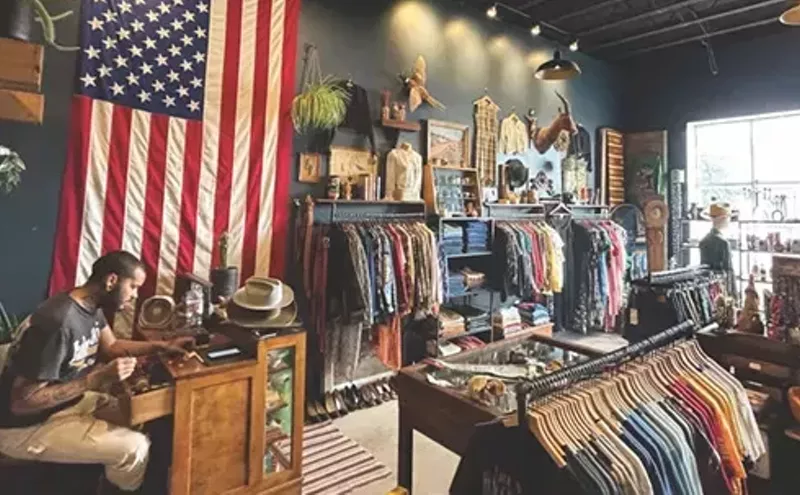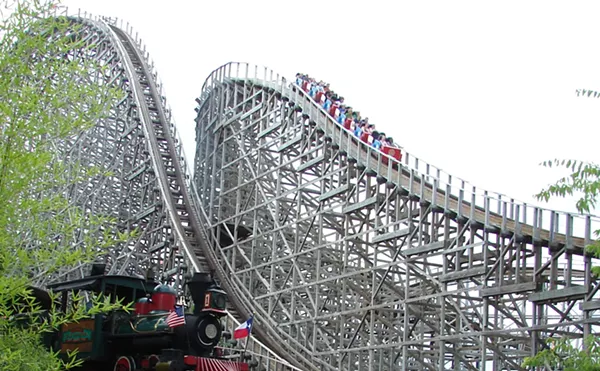Video games are more a part of our daily lives than ever. Those cranky parents who complained about their child's sedentary gaming habits never saw this coming.
We can not only frag strangers from the comfort of our couches through an Xbox One or PlayStation 4, we can also kill time in doctors' waiting rooms by building up resources in Clash of Clans or fend off creepers playing Minecraft during an Uber ride. Hell, we can even play games on our Apple Watches.
"The industry purely from a dollar standpoint is bigger than the music and film industries combined," says Brett Weiss, a video game historian and author of several books on classic gaming. "Everybody plays video games. I'd say over half, upwards of 60 to 70 percent of people play video games, whether it's on their phone or their computer or a console or a tablet. I think it's important to know where this stuff comes from."
The National Videogame Museum that officially opened to the public last Saturday as part of the Frisco Discovery Center doesn't just tell the history of an industry that's become a billion-dollar big boss. It surrounds visitors with interactive exhibits that take them on a tour of an industry and an art form that's still not done growing and innovating.
The concept of a video game museum has been in the minds of its founders Joe Santulli, John Hardie and Sean Kelly for years. Santulli, a collector who also runs a classic gaming fanzine and a gaming store in Clifton, New Jersey, through his Digital Press brand, says the three started a makeshift museum by merging their collections starting in 1999, for a regular exhibit at the Classic Gaming Expo in Las Vegas. The collection not only included rare pieces of gaming memorabilia but also exhibits that are now part of its permanent home — like a recreation of a 1980s kids' bedroom complete with a Nash brand skateboard, Star Wars bedsheets and a pristine Nintendo Entertainment console on a vintage television.
The event proved so popular that other industry events invited them to show off their collections at their conventions and their operation became a "traveling museum."
Santulli says they came to the conclusion that their pieces and exhibits needed a more permanent setting but knew such an undertaking would require a massive amount of planning, financial and city support. They found someone who could help them in 2012 in Las Vegas at the Interactive Academy of Arts and Science's annual convention, where their bedroom exhibit was being used to conduct interviews with notable names from the industry. One of the folks who sat down in a child's size bean bag chair to chat was Randy Pitchford, one of the founders of the game studio Gearbox Software, behind such critically acclaimed franchises as Borderlands and the upcoming Battleborn headquartered in Frisco.
"As I recall after his interview, he sat down and said something like, 'What are you guys? Do you guys want to build a museum?'" Santulli says.
Pitchford says he connected with the idea of a video game museum because he also had a collection of gaming artifacts in his Gearbox office as a constant reminder "to see where we've been as I'm working at my desk and working on where we're going."
He says he started talking with the three collectors about their plans and felt inspired to help because he wanted the public to see the obstacles the industry has overcome in order to inspire the next generation of game-makers.
"I invited John and the other guys to meet and visit with me at the studio," Pitchford says. "I thought if they visited Gearbox and saw how I cared for my own history in gaming, they probably would believe I had a similar deference to the history they had and at least believe that I wasn't full of it."
Santulli says the four started building plans for their video game hall of fame and realized that the key to making such a vision work would be getting the support of the museum's home turf. Santulli says they considered places like Silicon Valley, California, which is already home to similar attractions like the Computer History Museum, but the cost of a large enough space to accommodate the museum in that area was prohibitive.
"We just couldn't find the right fit for the product, so we were really lucky to have Randy as part of this process with the city of Frisco," Santulli says. "They were so gracious with us that there was just no way we could turn them down."
"Without Randy's help," Hardie says, "it wouldn't have happened."
Pitchford says he didn't need to do much convincing to get the city of Frisco on board.
"As we started discussing the possibility with members of the city like the mayor and the City Council and the different economic and community development corporations, we discovered they loved the idea and really got behind it," Pitchford says. "Once the city part was done, then it was off to the races."
The three co-founders already had an impressive collection they could put in the museum stored in warehouses all over the country. So they started the process of going through it to see what should go on display and what they would need to procure. One of the rarest pieces in the collection currently on display is a "Brown Box" console built in 1967-68 by video game inventor Ralph Baer."The industry has been extremely bad at taking care of its history." - David Crane, designer of Pitfall!
tweet this
"That was the fun part," Kelly says. "We actually got to go through all of our stuff that we haven't seen in like 10 or 15 years."
"This is the cream of the crop," Hardie says of the pieces on display in the museum. "This is the best stuff that we have here."
However, the team only had 10,000 square feet of space to work with and their collection could take up much more space than that. So Hardie says they tried to find a happy blend of rare pieces that tell the history of gaming and nostalgic reminders of gamers' childhoods.
"We had to be selective with what we showed because we wanted the most appeal," Hardie says. "For instance, we have a ton of rare Atari computer pieces and prototypes, but would the average person coming in care or even know about that stuff compared to a ColecoVision?"
Their other major goal was to make as much of the museum interactive as possible because video games are an interactive medium. So in addition to encased displays, they've also set up interactive displays that take visitors through the evolution of music in games and building fully contained worlds. Visitors can also play a number of consoles, computers and machines from every major generation and form of gaming, such as a massive Pong console on a 15-foot TV screen, rows of computers and video game consoles and a recreation of a 1980s video game arcade called Pixel Dreams. The arcade includes a number of standup cabinets such as Galaga, Centipede and Donkey Kong that take tokens from a working token machine.
They've also integrated some innovative concepts into the museum itself that go beyond just playing a game on retro tech, such as their exhibit on Easter eggs, the term for hidden levels, collectibles or images hidden in games, away from the player's central path. Pitchford says the museum's creators have hidden Easter eggs throughout the museum, turning the concept of a simple museum into its own living, breathing, fully immersive game.
Patrick Scott Patterson, a video game advocate and commentator who writes for SyfyGames and GameRoom Magazine and also helped revamp the U.S. National Video Game Team, got to take a tour of the museum before its official opening.
"It's very exciting to see something like this finally come together," Patterson says. "Video gaming has had this long, storied history that's deserving of something like this for a very long time. It's almost like they went into my mind as a child and brought it here."
Weiss also got to see a preview of the space and says it's "like walking into a time warp back in the late '70s and '80s."
So why do we need a space dedicated to video games? Hardie says he gets this question a lot. "I say that it's not just the games," Hardie says. "There are two museums in the United States for carrots. There's one for vacuum cleaners and washing machines."
Patterson says the influence of video games reaches far beyond the boundaries of the screens, or even its economic impact. "All the other forms of entertainment have been influenced by video gaming in some way," he says. "Those first video game generations have grown up to be producers and TV stars, and it impacted our lives just in the same way that films and songs have impacted previous generations."
The museum also gives some of the industry's pioneers a place to be honored and remembered for the foundation they created for global entities like Nintendo and Microsoft.
"The industry has been extremely bad at taking care of its history," says David Crane, a well-known video game programmer and designer best known for the game Pitfall!, who serves on the museum's board of directors. "These guys [Santulli, Hardie and Kelly] three-handedly or six-handedly as a group managed to preserve things that the biggest companies in the industry were unable to."
"It's not unheard of because if you think about it, you hear similar stories for the movie industry and how there are no original prints of some of these movies," adds Garry Kitchen, another well-known game programmer who worked on some of the earliest home video game titles and consoles and also serves on the museum's board of directors. "It's the same thing here, only these guys singlehandedly recognized it and made it their passion to do it."
The opening could just be the title screen to an impressive, interactive experience. Santulli says they originally drew up plans for a 50,000-square-foot space for their collections and that he envisions the museum as a place where visitors can access any title from the entire history of gaming the same way they'd pull a book off of a shelf at a public library or listen to a record from a music archive.
"The real story is about all the stuff that isn't yet on display," Pitchford says. "We need this museum to be really successful so we can see more of the collection and show people more about the history of video games."












